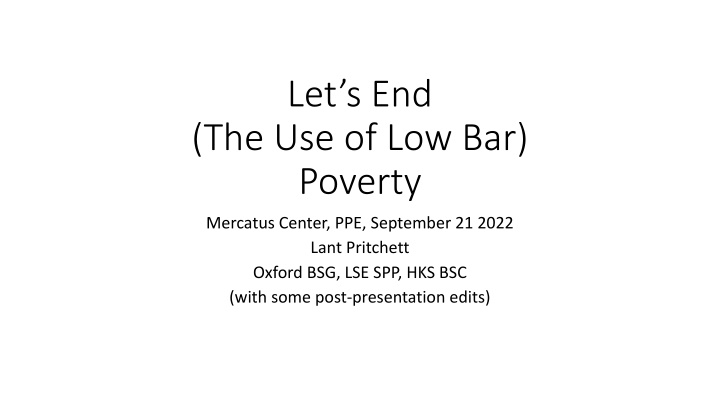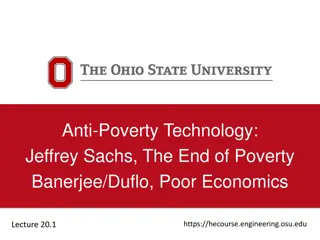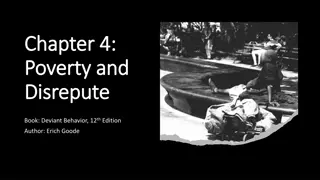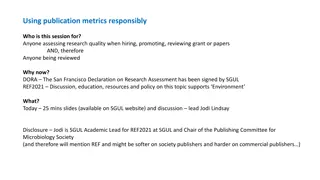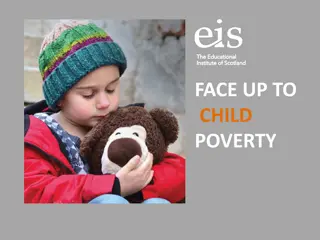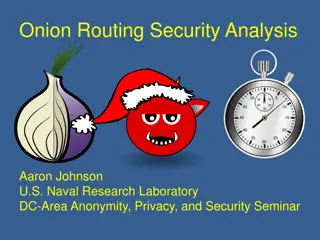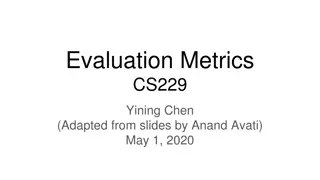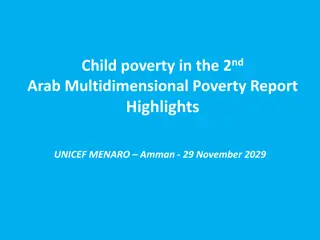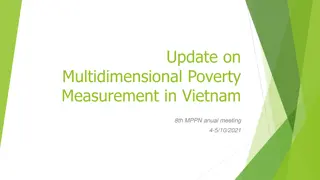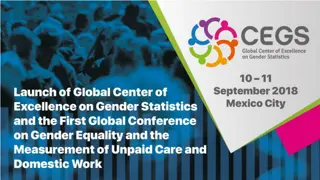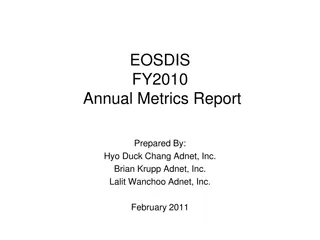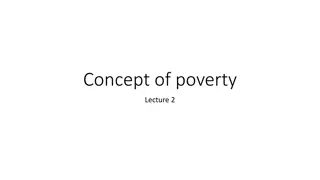Rethinking Poverty Analysis: Moving Beyond Low-Bar Metrics
Development economics has been dominated by the use of low-bar poverty lines, leading to significant analytical and moral shortcomings. This article challenges the common practice of setting poverty lines based on minimal standards, arguing that such approaches fail to capture the true complexities of poverty and well-being. By highlighting the flaws in current poverty measurement methods, the author advocates for a more nuanced and comprehensive approach to poverty analysis.
Download Presentation

Please find below an Image/Link to download the presentation.
The content on the website is provided AS IS for your information and personal use only. It may not be sold, licensed, or shared on other websites without obtaining consent from the author.If you encounter any issues during the download, it is possible that the publisher has removed the file from their server.
You are allowed to download the files provided on this website for personal or commercial use, subject to the condition that they are used lawfully. All files are the property of their respective owners.
The content on the website is provided AS IS for your information and personal use only. It may not be sold, licensed, or shared on other websites without obtaining consent from the author.
E N D
Presentation Transcript
Lets End (The Use of Low Bar) Poverty Mercatus Center, PPE, September 21 2022 Lant Pritchett Oxford BSG, LSE SPP, HKS BSC (with some post-presentation edits)
Overview of my argument For the last 30 years development economics has experienced a massive Gresham s Law phenomena in which bad economics--poverty analysis with low bar poverty lines--has driven out pre-existing better economics, (variants on) standard Social Welfare Functions. The only distinguishing feature of poverty measures as normative assessment or as goal/objective (versus the large class of SWF) is that above the poverty line the derivative of poverty wrt is exactly zero. Therefore poverty analysis is only defensible, either as economics or more broadly, morally (in a Kantian/Golden Rule sense), if we/you/one using poverty as a goal is comfortable with the claim that the gain to a valid normative assessment of income gains is well approximated by zero at an income marginally above the poverty line. At any of the commonly used low bar poverty lines (such as dollar a day which is now $1.90/day, or nutritional needs lines or even small multiples of those lines (such as two dollars a day ) this assertion is (orders of magnitude) empirically indefensible and, I would argue, morally obscene as it asserts that you (the user of poverty ) value the income gains infinitely less than the people who experience those gains do or than you would if they were your income gains.
Outline of the paper How did we get to dollar a day poverty? (a brief intro to poverty measures and poverty lines) The four inevitable analytical mistakes of any P(LBPL): Mistake 1: There is no line Mistake 2: The gains to any plausible definition of HH ell-being are not well approximated by zero and for that LBPL are off by at least an order of magnitude. Mistake 3: P(LBPL) treats income gains that are nearly equal as infinitely different. Mistake 4: P(LBPL) treats income gains that are very different as exactly the same These analytical mistakes contribute to big mistakes in development practice
(Too) Brief Intro to Poverty and LBPL Updated version showing that the LBPL are simply the poverty lines of the poorest countries (note the median for each group is used) Analytical basis In connection with the World Bank World Development Report 1990 on poverty the report needed a headline poverty number The Foster Greer Thorbecke (1984) class of measures had a poverty line The poverty line was deliberately chosen to be the lowest possible/feasible/credible poverty line The analytical justification for dollar a day as the line was an S curve in national poverty lines and roughly poverty line of the poorest countries was chosen (Ravallion, Datt, and Van de Walle 1991) Note that this method of choosing a global LBPL need not produce a line with any particular desirable properties. Ferreira and Sanchez-Paramo 2017
This one specific measure, the dollar a day poverty line, FGT headcount took on a life of its own Enshrined in the MDGs The World Bank changed its objectives to reflect it Campaigns like Let s End Poverty sprung up Often what was meant by poverty reduction was this measure of extreme poverty
Mistake 1: There is no line There are sometimes lines in natural phenomena David Lynch s great scene in the movie Mulholland Drive No Hay Banda in which one hears music while the announcer says There is no band Just because people talk about a poverty line and provide measures of poverty at a poverty line does not mean there is a non-arbitrary poverty line H20 (water) undergoes transitions across states from solid to liquid to gas at specific temperature thresholds (0 and 100 C at atmospheric pressure) Around black holes there is an event horizon In network phenomena there are key network metrics such that dynamics are radically different above and below the threshold
Mistake 1: There is no line in human wellbeing Measure of individual/HH wellbeing either subjective (e.g. utility ) or physical (e.g. child nutrition, basic infrastructure (sanitation, electricity), etc. What a line at a poverty line would look like (very different slopes/dynamics on either side of a line range of incomes What the actual relationships actually look like, pretty smooth (not necessarily linear, could be log-log, level-log, polynomial) but smooth HH income (per person, per EA)
Mistake 1: There is no line in poverty dynamics What one might mean by a poverty line is that here is a poverty trap such that the future income dynamics of those below a poverty line are different than those above a poverty line. However, with the advent of an increasing number of panel data sets it became clear that poverty was a condition of HHs that they transited in and out of rather than a characteristic of HHs (like being left-handed) (e.g. Ravallion and Chen for China). Moving Out of Poverty (Narayan-Parker, Pritchett, Kapoor 2009) examined 10 year transitions in income status in 17 regions and found that transitions out of poverty were similar to movements upwards of the income group just above the non-poor and that transitions into poverty were often as common as transitions out Not to mention the phenomena of very rapid reduction in P(LBPL) in rapidly growing countries like China, Vietnam (and formerly Indonesia and others) belied the notion that pre-existing poverty was to any great extent people in a person/HH specific poverty trap dynamic (as opposed to living in a poor, slowing growing, place) Some fraction of poverty are chronic poor who are persistently poor but these are typically a small fraction of the total poor and are trapped by characteristics (e.g. widowhood without support) rather than poverty (low-income) itself.
Mistake 2: The gains to wellbeing from income gains at a LBPL are not well approximated by zero If you are a trained economist you should already be convinced as: a) Deaton (2008) and Stevenson and Wolfers (2008) find that self reported wellbeing and income are roughly log- linear all the way up b) Stevenson and Wolfers (2013) find that the increment to wellbeing is often (typically) higher for those above $15,000 than below
Mistake 2: Evidence 2 for dWB/dY(LBPL)>>>0, food shares A typical way in which cost of basic needs poverty lines are constructed (see, for instance, Pradhan, Suryahadi, Sumarto and Pritchett 2003 for a fully consistent algorithm of this type) is: a) Estimate the cost of reaching 2,000 calories per person at the food basket consumed by those at the poverty line and that is the FPL b) Add to the FPL either (b.1) the spending on non-food of those whose total income is the FPL (lower) or (b.2) the spending on non-food of those whose actual food spending is the FPL Either way, this method for setting a LBPL guarantees the food share of consumption spending is very high (both average and marginal) So to use a LBPL you have to assert: I am comfortable with a valuation of zero of the income gains of HHs who are spending more than half of those income gains on food This is ridiculous.
Mistake 2: (new) Evidence 3 for dWB/dY(LBPL)>>>0, evidence from the association of GDPPC and basics Suppose you were not convinced by subjective wellbeing Suppose you were not convinced by anything involving HH expenditures. I am going to create an index of basics of material wellbeing based on physical indicators (e.g. child mortality, malnutrition, education, sanitation) and show that the increment to this index of basics from gains to GDPPC is very high well above the poverty line
No matter how one constructs an multiple indicator index of basics of material human wellbeing the association with GDPPC is strong, non- linear, necessary and sufficient Source: Pritchett with Lewis (2022)
What is the marginal gain to wellbeing in a development objective function? Standard poverty analysis says it is zero above the poverty line that it is near zero at any World Bank used poverty line is completely nuts it could only be true at a very high line (well above the poverty lines of OECD countries) The idea that the normative objective of development is reduction of poverty and that poverty is defined such that the gain from additional income/consumption above the poverty line is zero at a very low level of consumption is both theoretically, practically and morally obscene. Even at the World Bank s high poverty line of P$5.5/day: (i) the food share of consumption is around .6, (ii) the elasticity of basics wrt GDPPC is rising,(iii) the elasticity of child mortality wrt to consumption expenditures is rising. Source: Recent blog of mine
Mistake 3: People who are nearly identical are treated as infinitely different (because some count at exactly zero)
Mistake 4: Treat very different HHs (in income and hence in MU) exactly the same (because both count at exactly zero)
Big Picture Practical Mistakes in the Development Industry That Low Bar Poverty Lines Facilitate The shift from national development (four-fold transformation at country level) to programmatic efforts to improve human wellbeing when national development matters and in particular a belief that targeted programs are equally (or substantially) important to poverty reduction as economic growth Poverty analysis has led to the belief there is a group called the poor and that actions to help specifically these people are a key element of development actions but this is false (poverty is a condition, not a characteristic) and, at LBPL, cannot be a democratically sustained organizing objective for government
The premise of development practice was that the fourfold transformation of development: higher productivity, greater administrative capability, more responsive governments and more equal legal treatment would lead to higher human wellbeing. This is and remains true, in spades. National development is empirically necessary and sufficient for omnibus measures of human wellbeing Source: Pritchett 2022
J-PAL is saying things like: growth is not enough and programs are equally important Two things JPAL: 1) This statement is empirically false (by at least two orders of magnitude, the correct proportion is more like .5 percent than 50 percent see next slide) and is based on zero evidence (pretty striking for an organization that claims it wants to promote the use of rigorous evidence) For good reason, economic growth has long been a top policy goal for countries around the world. But for millions of people living in poverty, growth is not enough. Specific, targeted social programs based on rigorous empirical evidence are equally important to prevent people from being left behind. 2) This statement is only possible if one uses LBPL to (deliberately) make Mistake 4 versus a reasonable SWF. That is, specific targeted social programs cannot be anywhere near as important as growth to improvements in human wellbeing overall if one puts any weight on the gains of those at all levels of income because then the absolute gains of those in the distribution above the poverty line matter in ways that targeted programs cannot make a different to.
Not just some of or most of but essentially all (in cross-section) and nearly all (in long episodes) of reduction in income/consumption poverty is associated with levels or long episode changes in the median Source: Pritchett 2020
Table 1: An extreme poverty goal is extremely exclusionarygains to the middle income groups in nearly every country in the world are not included as progress by a goal of eradicating extreme poverty Country Name Pop l Gains to citizens at the specified percentile of the distribution included in a poverty goal? 60th 60th USA poverty line $15 per day 60th Half of US poverty line 80th 40th (All middle income groups are excluded by an extreme poverty goal in the countries in bold) Extreme Poverty ($1.25 per day) China India Indonesia Brazil Pakistan Nigeria Bangladesh Russian Mexico Philippines Ethiopia Vietnam Egypt Iran Turkey Democratic Republic of Congo Thailand South Africa Tanzania Colombia Total population of countries in which gains to the "middle class" (by each definition 80th, 60th, 40th) is excluded by an "extreme poverty" goal 1357.4 No 1252.1 No 249.9 No 200.4 No 182.1 No 173.6 No 156.6 No 143.5 No 122.3 No 98.4 No 94.1 No 89.7 No 82.1 No 77.4 No 74.9 No 67.5 Yes 67.0 No 53.0 No 49.3 No 48.3 No No No No No No No No No No No No No No No No Yes No No Yes No No No No No No Yes Yes No No No No No No No No Yes No No Yes No Yes Yes Yes Yes Yes Yes Yes Yes Yes Yes Yes Yes Yes Yes Yes Yes Yes Yes Yes Yes Yes Yes Yes No Yes Yes Yes No No Yes Yes Yes Yes Yes No Yes Yes Yes Yes Yes 4640 4572 4523 4193 0 541
P(LBPL) cannot be the basis of a country strategy The previous slide shows that you cannot pretend to have a democratically determined country-owned strategy with P(LBPL) at its center as this would imply a government telling more than half the population they are not central to the overall government strategy. The point of that is not that governments will adopt P(LBPL) as their strategy, but just that the gap between what governments/citizens in the South want to do and what development organizations support gets had to bridge with kinky development focused on low-bar goals (e.g. Pritchett 2015 or video of presentation).
